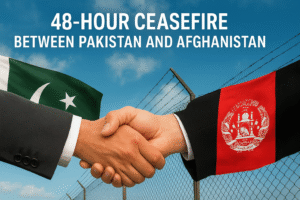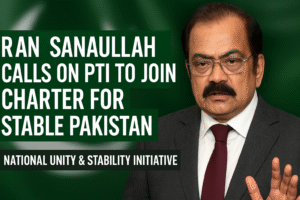48-Hour Ceasefire Between Pakistan and Afghanistan Agreed
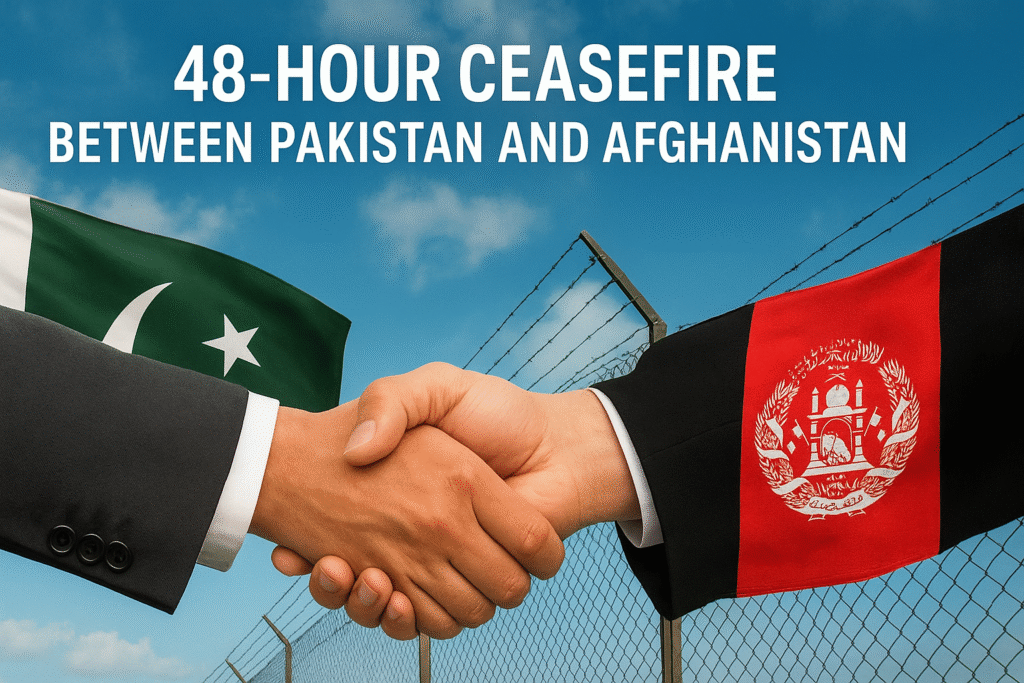
Introduction: A Fragile Pause in a Volatile Region
In a significant development late Tuesday night, Pakistan and Afghanistan have reportedly agreed to a 48-hour ceasefire following a series of deadly border clashes in Kandahar province that left dozens dead on both sides. The truce, confirmed by diplomatic sources and regional media, aims to de-escalate the rapidly deteriorating security situation that threatened to spiral into a full-scale conflict between the two neighboring states.
This short-term ceasefire, while temporary, marks a critical step in re-establishing communication channels and underscores the urgent need for regional stability. Both sides have been under mounting pressure from the international community, particularly the United Nations and the Organization of Islamic Cooperation (OIC), to prevent the conflict from escalating further.
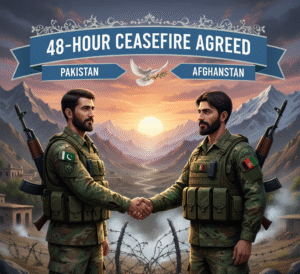
Background: How the Border Clashes Erupted
The current round of hostilities began earlier this week when Pakistani military posts came under heavy fire from across the border near the Spin Boldak-Chaman crossing, a vital trade route between the two nations. According to the Inter-Services Public Relations (ISPR), Pakistan’s military responded “in self-defense,” targeting militant positions inside Afghanistan’s Kandahar province, which reportedly harbored elements of the Tehrik-i-Taliban Pakistan (TTP).
Afghan officials, however, accused Pakistan of violating Afghan airspace, claiming that airstrikes resulted in civilian casualties. The situation escalated quickly, leading to a suspension of border trade and the displacement of hundreds of residents on both sides.
By Wednesday morning, at least 23 people were confirmed dead, and scores injured, forcing humanitarian agencies to issue evacuation alerts for local populations.
Diplomatic Response and Calls for Calm
In response to the clashes, Pakistan’s Foreign Office issued a statement emphasizing the need for restraint, reiterating that Pakistan “respects Afghanistan’s sovereignty” but reserves the right to defend its borders against terrorist threats emanating from Afghan soil.
Meanwhile, the Afghan Ministry of Defense condemned the airstrikes as “aggression,” calling on Islamabad to seek dialogue instead of confrontation. However, by Wednesday evening, both sides confirmed through intermediaries that talks had resumed, leading to a temporary 48-hour ceasefire agreement brokered by Qatar and China, who serve as key interlocutors for regional stability efforts.
The Role of Mediation: Qatar, China, and OIC
Multiple diplomatic sources have revealed that Qatari and Chinese envoys played a pivotal role in de-escalating tensions. Qatar’s foreign office released a brief statement urging “both brotherly nations to exercise utmost restraint.” Meanwhile, China — a major investor in regional connectivity through the China-Pakistan Economic Corridor (CPEC) — called for “responsible engagement” to ensure that “peace and cooperation prevail over confrontation.”
The OIC also welcomed the ceasefire, stating it is ready to assist in any dialogue process aimed at achieving “long-term peace between the two Islamic nations.”
Ground Situation: The Humanitarian Toll
As reports of the ceasefire emerged, humanitarian workers began assessing the damage in the border districts of Chaman (Pakistan) and Spin Boldak (Afghanistan). Local hospitals have been overwhelmed with casualties. Aid organizations such as the Red Crescent and Médecins Sans Frontières (MSF) deployed emergency medical teams to both sides of the border.
“Entire families have been displaced. Shops are shuttered. The main highway is deserted,” said Dr. Aslam Baloch, a volunteer doctor stationed near Chaman. “Even if the firing stops temporarily, the fear remains.”
Economic Implications: Trade and CPEC at Risk
The Chaman-Spin Boldak border crossing is not only a transit route but also a lifeline for bilateral trade, handling goods worth millions of dollars daily. The clashes forced a complete shutdown, halting the movement of trucks carrying perishable goods and consumer supplies. Traders have reported heavy losses.
Analysts warn that prolonged instability could have serious repercussions for Pakistan’s economy, especially as Islamabad navigates a fragile recovery under its new IMF bailout agreement worth $1.24 billion. Confidence in regional security is essential for continued foreign investment in infrastructure projects, particularly those linked to CPEC Phase-II.
Security Analysis: The TTP Factor
The Tehrik-i-Taliban Pakistan (TTP) remains at the core of the tensions. Pakistan has long accused the Afghan Taliban of harboring TTP militants, who allegedly use Afghan territory to launch attacks inside Pakistan. Despite repeated assurances from Kabul, Islamabad believes the Afghan interim government has not taken concrete steps to dismantle these sanctuaries.
Security expert Lt. Gen. (R) Amjad Shoaib commented that “the ceasefire is a necessary pause, but without a serious crackdown on the TTP, no amount of diplomacy will hold.” He warned that Pakistan’s military patience “has limits,” especially after multiple cross-border attacks in Khyber Pakhtunkhwa (KP) and Balochistan provinces.
Regional Reactions: US, UN, and Neighbors Watch Closely
The United Nations Secretary-General António Guterres expressed deep concern, urging both sides to maintain the ceasefire and begin dialogue. “Civilians must never be caught in the crossfire,” he said in a statement.
The United States Department of State reiterated its position that both countries should “engage through diplomatic channels to reduce tensions,” while neighboring Iran and China both emphasized non-military solutions to border disputes.
India, observing from afar, has yet to issue a formal statement but continues to monitor the situation closely through intelligence reports.Timeline of Escalation and De-escalation
-
October 12, 2025: Clashes erupt near Spin Boldak; multiple casualties reported.
-
October 13: Pakistan conducts limited airstrikes targeting suspected militant hideouts.
-
October 14: Afghan officials accuse Pakistan of civilian casualties; diplomatic protests lodged.
-
October 15: Qatar and China intervene; 48-hour ceasefire announced.
-
October 16: Joint border monitoring teams established to prevent renewed hostilities.
Expert Commentary: What Happens Next?
Dr. Maleeha Lodhi, Pakistan’s former UN Ambassador, called the ceasefire “a window of opportunity for diplomacy.” She noted that both countries “stand to lose far more from confrontation than from cooperation.”
Similarly, Barnett Rubin, a senior fellow at NYU specializing in Afghan affairs, observed that “without a formal border demarcation and security mechanism, flare-ups like these will continue.”
Voices from the Ground
Local residents from Kandahar’s Spin Boldak region told local journalists that the ceasefire was a “welcome relief,” but skepticism remains. “We’ve heard promises before,” said Ahmadullah, a truck driver stranded at the border. “But unless there is lasting peace, business and life here can never return to normal.”
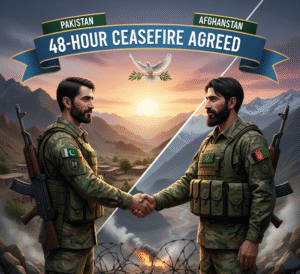
Media Coverage and Public Reaction
Pakistani media hailed the ceasefire as “a diplomatic success for Islamabad,” while Afghan outlets framed it as “a necessary step to prevent civilian suffering.” On social media, hashtags like #PakistanAfghanistanCeasefire and #PeaceForKandahar trended across both countries, reflecting public fatigue over prolonged conflict.
Military Preparedness and Border Policy
The Pakistan Army, while confirming its commitment to the ceasefire, has reportedly placed its border units on high alert. A spokesperson for the ISPR stated that Pakistan “reserves the right to respond decisively to any provocation” but reiterated that “peace is always our preferred path.”
Afghan defense sources, on the other hand, claim their border guards are “fully mobilized” to prevent incursions and monitor adherence to the truce. Pakistan, Afghanistan, Ceasefire, Kandahar, Border Clashes, Taliban, ISPR, Foreign Policy, South Asia, Security, Diplomacy, Pakistan Army, Peace Talks, Regional Stability.
International Perspective: The Bigger Picture
The Pakistan-Afghanistan border remains one of the most volatile frontiers in the world, shaped by decades of mistrust, militant activity, and competing geopolitical interests. The Durand Line dispute, unresolved since 1893, continues to complicate modern diplomacy.
For global powers, stability in this corridor is essential for combating terrorism, ensuring humanitarian access, and maintaining the broader South-Central Asian security architecture. Pakistan, Afghanistan, Ceasefire, Kandahar, Border Clashes, Taliban, ISPR, Foreign Policy, South Asia, Security, Diplomacy, Pakistan Army, Peace Talks, Regional Stability. 48-Hour Ceasefire Between Pakistan and Afghanistan Agreed.
Conclusion: A Chance for Lasting Dialogue
The 48-hour ceasefire, though limited in scope, represents a crucial test of political will. Whether it leads to a permanent peace framework depends largely on both governments’ ability to address the underlying causes of mistrust, including border security, refugee management, and militant sanctuaries. Pakistan, Afghanistan, Ceasefire, Kandahar, Border Clashes, Taliban, ISPR, Foreign Policy, South Asia, Security, Diplomacy, Pakistan Army, Peace Talks, Regional Stability. 48-Hour Ceasefire Between Pakistan and Afghanistan Agreed.
Pakistan’s leadership, under Prime Minister Shehbaz Sharif, has repeatedly emphasized that “peace in Afghanistan is peace in Pakistan.” Similarly, Taliban officials have declared willingness to “resolve disputes through dialogue.”



